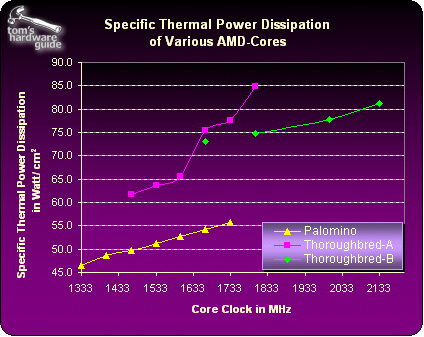A Cool Bunch: How To Put A Lid On The Die Temperature Of Your Athlon
A Round-up Of 55 Coolers For AMD Processors

The gigahertz battles waged by the two processor makers AMD and Intel are glad tidings for users: they have never had access to so much (excess) power for such relatively low prices.
Of course there's a hitch to it all - riding in the wake of clock speed increase is a jump in electrical power consumption, or rather, the power loss of the gigahertz bolides. And, while manufacturers try to keep down power loss by constantly miniaturizing the processor structures (smaller transistors switch at lower voltages, which means they dissipate less power), they continue to cram ever more transistors onto rapidly shrinking surfaces. As a result, the specific power dissipation of today's processors has mushroomed. And that has raised the bar for CPU coolers, too.

Specific power dissipation of different AMD cores.
AMD has ventured down the correct path with its latest progeny, the Athlon XP with a Thoroughbred "B" core. The surface area of the die was expanded 5% to 84 mm2, which put its power loss several steps below that of its predecessor (as measured by clock increase). But if you compare the CPU die to a 100 watt light bulb, its specific thermal power is still fiery: while a heat lamp generates a wimpy 0.95 watts/m² (5% efficiency, surface area around 100 cm²), the latest Athlon XP2600+ churns out some 81 watts/cm². So the moral of the story is that many a little makes a lot - in this case, a lot of heat that desperately needs to be dissipated. Unless, of course, you enjoy seeing your processor disintegrate in a flash of smoke.
Stay on the Cutting Edge
Join the experts who read Tom's Hardware for the inside track on enthusiast PC tech news — and have for over 25 years. We'll send breaking news and in-depth reviews of CPUs, GPUs, AI, maker hardware and more straight to your inbox.
Current page: A Round-up Of 55 Coolers For AMD Processors
Next Page The Theory Behind The Dream CoolerMost Popular

